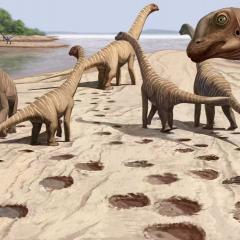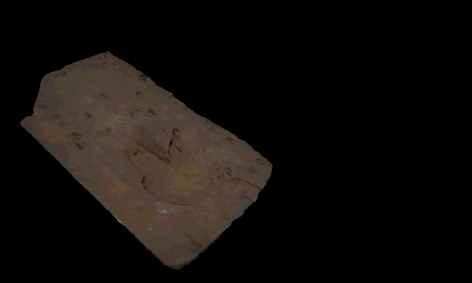
Palaeontologists from The University of Queensland have reaffirmed the idea that the set of large footprints at Lark Quarry in outback Queensland were made by a plant-eating ornithopod dinosaur, as opposed to a predatory theropod. The study also shows that these tracks were formed well before any of those thought to have been associated with the site’s ‘dinosaur stampede’.
The new study, led by School of Biological Sciences PhD candidate Anthony Romilio, used a technique known as photogrammetry to digitally map each of the largest footprints in 3D.
“The footprints have round toe-prints, similar to Iguanodontipus tracks that are found across Europe and China, verifying that they were made by an large ornithopodan dinosaur,” Romilio said. “Our results also show that the large ornithopod crossed the area shortly before the site was covered in shallow water.”
Lark Quarry, also known as the Dinosaur Stampede National Monument, is located 110 km south of Winton in central-western Queensland, and contains over 3,000 dinosaur footprints. Since the 1970’s, the site had been famed for preserving the footprints of a carnivorous dinosaur that approached a mixed herd of chicken- and turkey-sized dinosaurs, causing them to stampede.
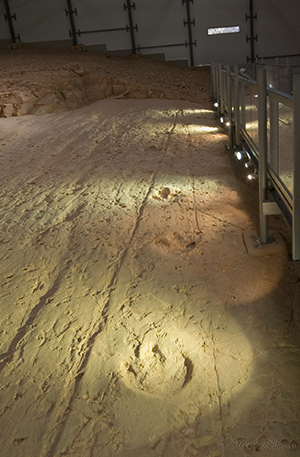
“All these dinosaurs were on the move, that’s for sure. But rather than all being present during one event, the footprints were made in a series of separate events over a longer period of time,” Romilio said.
“By digitally mapping portions of the tracksite in 3D it is possible to accurately determine the shape of the footprints, what the dinosaurs that made them were doing, and what the ground surface conditions were like when the footprints were made”, Romilio said.
“There are sediment ridges inside some of the large footprints, which is a tell-tale sign of mud sticking to the foot of the trackmaker. From this we can conclude that the large ornithopod moved across the tracksite when the ground was squishy but not covered in water”.
Romilio’s advisor and co-author of the study Dr Steve Salisbury from UQ’s School of Biological Sciences, said that the results also had important implications for the timing of various events at the world famous tracksite.
“The 3D models show that there are pressure bludges surrounding the large footprints, and that many of these are cut by the drag marks caused by partially floating vegetation.”
“This indicates that water covered the site after the large tracks were made”, Salisbury said.
“The pressure bulges and drag marks are also dotted with smaller footprints, indicating that Lark Quarry’s small-bodied dinosaurian trackmakers traversed the site some time after the drag marks for formed, and definitely after the large ornithopod walked through. Based on our earlier research, we know some of these smaller dinosaurs were swimming.”
“The time over which various tracks were made at the site could range from a few hours to several days,” Salisbury said.
“It’s definitely not a ‘moment’ frozen in time.”
These conclusions contrast with the original interpretation of Lark Quarry that was published in 1984, in which the vegetation drag marks were thought to have formed first, allowing the large and smaller dinosaurs to be at the site at close to the same time.
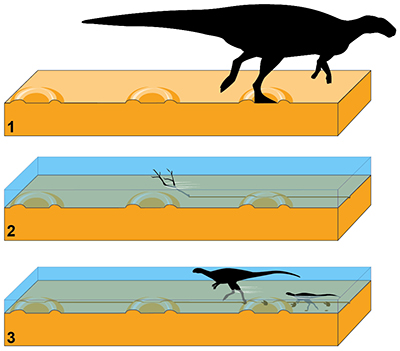
inferred in the new study. Illustration © Anthony Romilio,
The University of Queensland.
But the differences do not stop there.
The size and shape of some of the large footprints also seems to have been misrepresented in the original study.
“The actual footprints are only around ¾ of the size documented by previous researchers”, Romilio said.
“Since footprint length is used to work out trackmaker size, we now estimate the large Lark Quarry dinosaur to have been considerably smaller than it was initially thought to be: around 1.9 m high at the hips as opposed to the original estimate of 2.6 m.”
“A part of the problem was probably the old technique of recording footprints as 2D outlines. Footprints are 3D structures so mapping them as such takes out the guess-work,” Romilio said.
A case in point is the ‘V’-shaped outline that was given to some of the toe impressions in the 1984 study. These pointed toe impressions were used as evidence for inferring that the big dinosaurian trackmaker was a theropod.
“These shapes simply don’t occur at Lark Quarry”, Romilio stated.
“The actual toe impressions on the large tracks were rounded at the tips, as would be expected for a plant-eating dinosaur. But instead of tracing the outline the actual footprint shapes, the original researchers traced along intersecting cracks in the track surface. The end result is a very different outline to the one that we can now produce using 3D photogrammetry.”
The original interpretation of Lark Quarry as a ‘dinosaur stampede’ has made the tracksite internationally renown. Although Romilio’s research has cast serious doubt over the original stampede scenario, it also highlights the fact that what actually happened at Lark Quarry 92–94.5 million years ago might be far more interesting.
“In a study that was published in 2013, we were able to show the small dinosaurs left their footprints during multiple events and not in a single, running stampede,” Romilio said. “We even showed that some of them were swimming as water levels at the site fluctuated.”
“I’ve since been contacted by palaeontologists in the US and China who tell me they have seen similar types of dinosaurian swim traces at other sites.”
Romilio’s 2013 paper on Lark Quarry recently won the prestigious 2014 Society of Vertebrate Paleontology Taylor and Francis Award for the Best Student Article in the Journal of Vertebrate Paleontology.
Romilio will receive the award at the 74th Annual meeting of the Society of Vertebrate Paleontology in Berlin in November.
“It has been such an honour to have the Society nominate me, and to actually win has really encouraged me to continue with my research.”
See the UQ News version of this story here
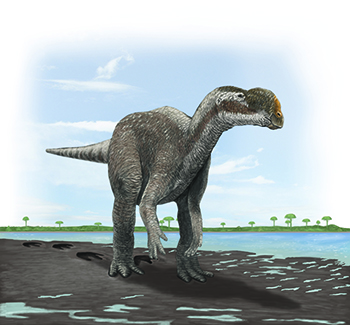
The new Lark Quarry paper has been published online in Cretaceous Research.
Romilio, A. and Salisbury, S.W. 2014. Large dinosaurian tracks from the Upper Cretaceous (Cenomanian–Turonian) portion of the Winton Formation, Lark Quarry, central-western Queensland, Australia: 3D photogrammetric analysis renders the ‘stampede trigger’ scenario unlikely. Cretaceous Research 51, 186-207. pdf + SI
More information about dinosaur-related research at UQ can be found here
Media: Anthony Romilio (+61 430 514 169; a.romilio@uq.edu.au); Dr Steve Salisbury (+61 7 3365 8548 or + 61 407 788 660; s.salisbury@uq.edu.au)
Images and animated 3D models of the Lark Quarry dinosaur tracks are available for use from Aimee Parker +61 7 3346 1629, a.parker3@uq.edu.au
Listen to Anthony Romilio talk about his study with animated audioslides: large format, small format



